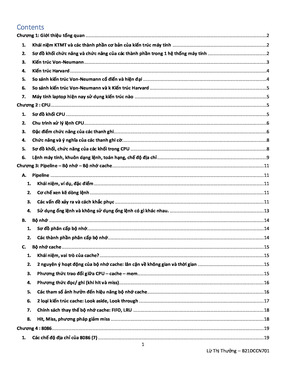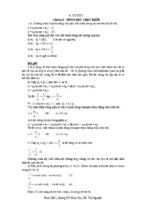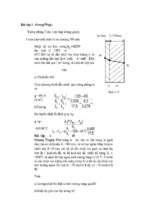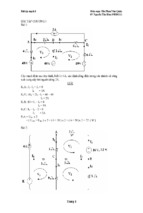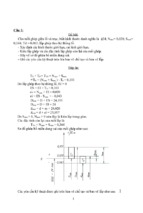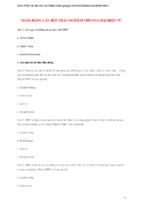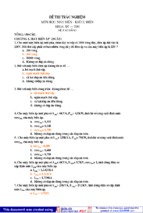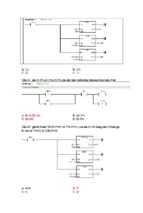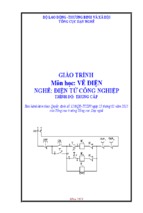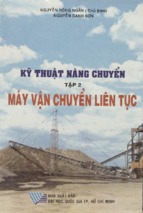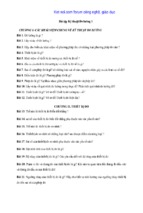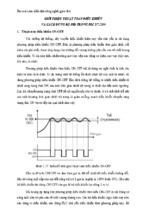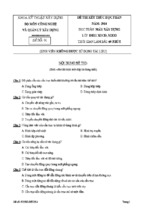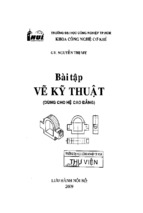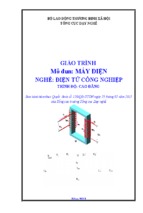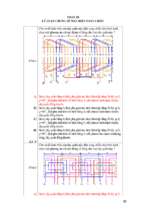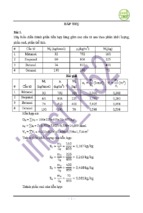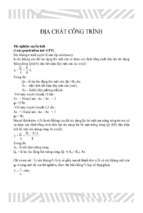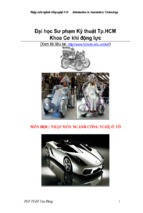1
BỘ LAO ĐỘNG THƯƠNG BINH VÀ XÃ HỘI
TỔNG CỤC DẠY NGHỀ
GIÁO TRÌNH
Mơ đun:Anh văn chuyên ngành
NGHỀ: ĐIỆN TỬ CÔNG NGHIỆP
TRÌNH ĐỘ: TRUNG CẤP
Ban hành kèm theo Quyết định số:120/QĐ-TCDN ngày 25 tháng 02 năm 2013
của Tổng cục trưởng Tổng cục Dạy nghề
Năm 2013
2
LỜI GIỚI THIỆU
Trong chương trình đào tạo ngành Điện tử công nghiệp ở các trường Cao
Đẳng Nghề, Tiếng Anh chuyên ngành Điện tử công nghiệp có một vị trí đặc biệt
quan trọng, trong bối cảnh hội nhập và hợp tác quốc tế thì Tiếng Anh chuyên
ngành phục vụ trực tiếp cho việc học tập và nghiên cứu của sinh viên về lĩnh vực
Điện tử công nghiệp. Để đáp ứng nhu cầu học tập và nghiên cứu của sinh viên tại
các trường Cao đẳng nghề, Trường Cao Đẳng Nghề LILAMA 2 vinh dự được
Tổng cục Dạy nghề giao nhiệm vụ tổ chức biên soạn theo quyết định số: 612/QĐTCDN ngày 14 tháng 11 năm 2011 .
Để thực hiện biên soạn giáo trình đào tạo nghề Điện tử công nghiệp ở trình
độ CĐN, TCN, Giáo trình mô đun Tiếng Anh chuyên ngành là một trong những
giáo trình mô đun được biên soạn theo nội dung chương trình khung được Bộ Lao
động Thương binh và Xã hội phê duyệt. Nội dung biên soạn ngắn gọn, súc tích và
dễ hiểu, tích hợp giữa kiến thức và kỹ năng, đồng thời mang tính logic.
Sau một thời gian dài tìm tòi, nghiên cứu và tổng hợp tài liệu, bằng tâm
huyết với nghề giáo và bề dày kinh nghiệm nhiều năm trong nghề, đội ngũ giảng
dạy Tiếng Anh kết hợp với giáo viên dạy chuyên ngành điện, điện tử… đã tổ
chức biên soạn giáo trình này.
Với phương châm làm việc theo tác phong công nghiệp và luôn cập nhật
tiêu chuẩn quốc tế trong tài liệu giảng dạy của nhà trường, Giáo trình thể hiện
được tính chuyên nghiệp và tính quốc tế trong việc trình bày những kiến thức
cũng như kỹ năng của ngành Điện tử công nghiệp nhằm phát triển vốn thuật ngữ
Tiếng Anh chuyên ngành, đồng thời tăng cường kỹ năng đọc và hiểu tiếng Anh
cho sinh viên.
Giáo trình được thiết kế với lượng thời gian 90 giờ gồm có:
Bài M20-01: Electrical Materials
Bài M20-02: Install Satellite Coax cables and electrical equipment
Bài M20-03: Install and check low voltage panel, medium voltage panel
and control panel
Bài M20-04: Install and check lighting control equipment
Bài M20-05: Electronic devices
Bài M20-06: Basic Electronic Equipment in Circuits
Bài M20-07: Basic Electronic Equipment in Use
Bài M20-08: Test and Repair Instrument
Bài M20-09: Safety in Industrial Electrical Application
Bài M20-10: Review and Final Test
Với nội dung và kiến thức đã biên soạn trong giáo trình phù hợp với mục
tiêu đào tạo anh văn chuyên ngành cho nghề Điên tử công nghiệp. Tuy nhiên,
lần đầu tiên xây dựng giáo trình chắc chắn không tránh khỏi những thiếu sót, rất
3
mong bạn đọc quan tâm, đóng góp ý kiến để chỉnh sửa và hoàn thiện giáo trình
này trong những lần tái bản sau.
Đồng Nai, ngày 10 tháng 06 năm 2013
Tham gia biên soạn
1. Chủ biên TS. Lê Văn Hiền
2. ThS. Lê Quang Trung
3. ThS. Nguyễn Thị Thanh Tuyền
4
MƠ ĐUN
ANH VĂN CHUYÊN NGÀNH ĐIỆN ĐIỆN TỬ CƠNG NGHIỆP
Mã mơ đun: MĐ 20
VỊ TRÍ, TÍNH CHẤT CỦA MƠ ĐUN:
Mơ đun Anh văn Chuyên ngành Điện tử cơng nghiệp là Mơ đun bổ trợ trong
danh mục các mơn học, mơ đun đào tạo nghề Điện tử cơng nghiệp.
Mơ đun này là giúp cho người học phát triển được kiến thức và kỹ năng cần
thiết về sử dụng Tiếng Anh chuyên ngành để đọc, hiểu các tài liệu kỹ thuật trong
lĩnh vực điện tử cơng nghiệp cũng như giao tiếp Tiếng Anh chuyên ngành trong
mơi trường làm việc tại doanh nghiệp.
MỤC TIÊU CỦA MƠ ĐUN
- Đọc và hiểu được các khái niệm cơ bản trong chuyên ngành ĐiệnĐiện từ bằng tiếng Anh
- Đọc và hiểu được các thiết bị điện, khí cụ điện, linh kiện điện tử bằng
tiếng anh
- Hiểu được một số thiết bị, ký hiệu điện điện tử bằng tiến anh
- Đọc được một số tiêu chuẩn kỹ thuật ứng dụng trong ngành điện điện
tử cơng nghiệp bằng tiếng anh
- Đọc và hiểu được tài liệu tiếng anh trong lĩnh vực điện và điện tử
cơng nghiệp, cĩ khả năng giao tiếp và sử dụng anh văn trong lĩnh vực
điện điện tử tự tin trong mơi trường làm việc của doanh nghiệp
- Tự giác, tích cực, chủ động và hợp tác trong học tập
NỘI DUNG MƠ ĐUN
Số
TT
1
1.1
1.2
1.3
Readin
g
Compr
ehensi
on
Tên các bài trong mơ đun
Thời gian
Tsố
LT
TH
KT
Electrical Materials
10
1
8
1
Vocabulary
0.5
0.5
Grammar
1.5
0.5
7
7
1
Hình thức
giảng dạy
5
Cond
ucting
Mater
ials
Semic
onduc
ting
Mater
ials
Insula
ting
Mater
ials
Magn
etic
Mater
ials
Speci
al
Mater
ials
1.4
2
2.1
2.2
2.3
2.4
3
Test
Install
Sattlite
Coax
cables
and
electrical
equipment
Vocabulary
Grammar
Reading Comprehension
- General rules for
installation
- Steps to install
- Test
Test
Install and check low
1
1
10
1
8
0.5
1.5
0.5
0.5
1
7
7
1
10
1
1
8
1
1
6
3.1
3.2
3.3
3.4
4
4.1
Vocab
ulary
4.2
4.3
4.4
5
5.1
775.2
5.4Rea
ding
Compr
ehensi
on
Semic
onduct
or
voltage panel, medium
voltage panel and control
panel
Vocabulary
Grammar
Reading Comprehension
- Install and check low
voltage panel
- Install and check Medium
voltage panel
- Install and check Control
panel
Test
Install and check control
equipment
and
measurement Chươngs
0.5
0.5
1.5
0.5
0.5
7
1
7
1
8
1
1
6
0.5
1
1
0.5
Grammar
Reading Comprehension
- Install and check control
equipment
Install and check
measurement Chươngs
1.5
Test
Electronic devices
Vocabulary
Grammar
Test
1
10
0.5
1.5
1
5
5
1
0.5
0.5
8
1
1
1
1
7
diodes
Thyris
tors
MOSF
ETS
Transi
stors
Resist
ors
Capaci
tors
Comp
onent
values
5.3
6
6.1
6.2
6.3
6.4
7
7.1
7.2
7.3
Basic
Electronic
Equipment in Circuits
Vocabulary
Grammar
Reading Comprehension
- Operational Amplifiers
- Timers
- Transistor Amplifiers
- Oscillators
- Converters
Test
Basic
Electronic
Equipment in Use
Vocabulary
Grammar
Reading Comprehension
- Batteries
- Remote control
10
1
8
0.5
1.5
0.5
0.5
1
7
1
7
1
1
10
1
0.5
1.5
7
0.5
0.5
8
1
7
1
8
7.4
8
8.1
8.2
8.3
8.4
9
9.1
9.2
9.3
9.4
10
Tổng
cộng:
- Alarm system
- Audio recording system
Test
Test
and
Repair
Instrument
Vocabulary
Grammar
Reading Comprehension
General
Safety
Considerations
Some
electronic
equipment used to test and
repair
- Some kinds of test
- Repair of Cracks
Test
Safety
in
Industrial
Electrical Application
Vocabulary
Grammar
Reading Comprehension
- Cause and effect of
accident
- Safety equipment
- Methods of avoiding
accidents
Test
Review and Final Test
90
1
1
10
1
8
0.5
1.5
0.5
0.5
1
7
1
7
1
1
10
1
9
0.5
1.5
0.5
0.5
1
7
7
1
2
1
1
10
70
1
11
9
Unit 1: ELECTRICAL MATERIALS
Nhằm giúp sinh viên có hướng tiếp cận dễ dàng trong việc học tiếng Anh
chuyên ngành Điện tử công nghiệp, trước hết giáo trình này giới thiệu cho sinh
viên về các thuộc tính và đặc điểm kỹ thuật của các loại vật liệu điện bằng tiếng
Anh. Qua đó, người học dễ nắm bắt được các kiến thức chuyên sâu hơn của các
bài học tiếp theo đồng thời có thể tra cứu các tài liệu liên quan bằng tiếng anh.
Mục tiêu của bài học:
Sau khi học xong bài học này, sinh viên có kiến thức và kỹ năng về sử dụng anh ngữ:
- Đọc hiểu được các thuật ngữ về vật liệu điện, điện tử bằng tiếng anh
- Hiểu được các từ trong cấu tạo và nguyên lý vật liệu dẫn điện, vật liệu
bán dẫn, vật liệu cách điện, vật liệu từ và các vật liệu đặc biệt khác
bằng tiếng anh.
- Sử dụng được thì hiện tại đơn để giao tiếp trong lĩnh vực điện bằng
tiếng anh.
- Tự tin giao tiếp tiếng anh chuyên ngành trong môi trường làm việc tại
doanh nghiệp
- Đọc hiểu tài liệu tham khảo bằng tiếng anh trong lĩnh vực điện
Nội dung của bài học:
I. VOCABULARY
Mục tiêu: Cung cấp cho người học các từ vựng trong lĩnh vực điện để người học
có thể đọc và hiểu được từ chuyên môn liên quan đến m ột s ố tài li ệu trong l ĩnh v ực đi ện đi ện t ử
công nghiệp bằng tiếng anh.
Resistivity (n)
Conducting (adj)
Category (n)
Transmission (n)
Distribution (n)
Transformer (n)
Copper (n)
Aluminium (n)
Coefficient (adj)
Variation (n)
Voltage drop (n)
Withstand (v)
Ductility (n)
Mould (v)
Solderability (n)
:
:
:
:
:
:
:
:
:
:
:
:
:
:
:
Điện trở
Dẫn điện
Loại
Truyền tải
Phân phối
Máy biến thế
Đồng
Nhôm
Hệ số
Biến thiên
Điện áp rơi
Chịu đựng
Độ dẻo dai
Đúc
Tính dễ hàn
Annealing (n)
Valence (n)
Insulating (adj)
Capacitor (n)
Thermoplastic
Thermosetting
:
:
:
:
:
:
Elastic (adj)
Solvent (n)
Brittle (adj)
Repellent (adj)
:
:
:
Molecule (n)
Elongate (v)
Elasticity (n)
:
:
:
:
Sự tôi luyện
Hóa trị
Cách điện
Tụ điện
Chịu nhiệt
Phản ứng
nhiệt
Đàn hồi
Dung môi
Dễ vỡ
Không thấm
nước
Phân tử
Giãn nở
Độ đàn hồi
10
Corrosion (n)
Precision (n)
Rheostat (n)
Melting (adj)
Oxidation (n)
Malleable (adj)
Tensile (adj)
Busbar (n)
Brass (n)
Bronze (n)
Constantan (n)
Fuse (n)
Socket (n)
Fluorescent
tube (n)
Electric bell (n)
Three-core cable (n)
Fuse wire (n)
Copper conductor
High- voltage
conductor(n):
Extension cord (n)
Electric tool (n)
Thermoplastic (n)
Meter (n)
Electric meter (n)
Cable gland (n)
Cable lug (n)
:
:
:
:
:
:
:
:
:
:
:
:
:
:
:
:
:
:
:
:
:
:
:
:
:
:
Sự ăn mòn
Độ chính xác
Biến trở
Tan chảy
Sự ô xy hóa
Dẻo
Chịu bền
Thanh cái
Đồng thau
Đồng đỏ
Hợp chất nikel
Cầu chì
Ổ cắm
Đèn huỳnh
quang
Chuông điện
Dây cáp 3 lõi
Dây chì
Dây dẫn đồng
Dây dẫn
cao thế
Dây dẫn nhánh
Dụng cụ điện
Tính chịu nhiệt
Đồng hồ đo
Đồng hồ điện
Cổ cáp
Đầu cốt
Polymerisation
:
Hysteresis (adj)
:
Saturation (n)
:
Magnetization (n) :
Curve (v)
:
Coercivity (n)
:
Adamantine (n)
:
Ultrahard (adj)
:
Darkwood (n)
:
Alchemical (n)
:
Metallurgy (n)
:
Alchemy (n)
:
Bypass (v)
:
Transmission
line (n)
:
Bulb (n)
:
Safety helmet (n) :
Outlet (n)
:
Earthed socket (n)
:
Underfloor
socket
:
Adapter (n)
:
Voltage stabilizer :
Cable clip (n)
:
Plug (n)
Sự polymer
hóa
Trễ điện môi
Bão hòa
Độ từ hóa
Uốn cong
Độ kháng
Chất adaman
Siêu cứng
Gỗ cứng
Luyện đan
Luyện kim
Thuật luyện
đan
Đường vòng
Đường dây
truyền tải
Bóng đèn tròn
Mũ bảo hiểm
Ổ điện
Ổ điện có
dây tiếp đất
Ổ điện ẩn
dưới sàn
Bộ nắn điện
Máy ổn áp
Nẹp ống dây
Phích cắm
II. GRAMMAR
Mục tiêu: Cung cấp cho người học cấu trúc ngữ pháp về thì hiện tại đơn để
người học có thể sử dụng trong quá trình viết hoặc giao tiếp trong công việc tại
nơi làm việc hoặc trong đời sống hằng ngày có liên quan.
2.1 The Simple Present Tense
The simple present tense
a. Structure
To form the Present Simple Tense we use the verb's base form (go, work,
speak, study). In 3rd person singular (he, she, it), the base form of the verb
11
takes -s/es. (Auxiliary verbs “be,” “do,” “have”, which can also be used as
main verbs, are exceptions.)
Affirmative form
I / You / We / They + V_infinitive
He/She/It + V_(s,es)
Example:
Electric current deals with charges in motion
I go to school every day.
Negative form
I / You / We / They + do not /don't +V_infinitive
He/She/It does not /doesn't / +V_infinitive
Example:
Interrogative form
She doesn't often go to the cinema.
I don't get up early at the weekend.
They don't speak English very well.
Do + I / You / We / They + V_infinitive
Does + He/She/It + V_infinitive
Example:
Do they speak foreign languages?
Does your sister play the piano?
Questions and short answers:
Do you like spaghetti?
Yes, I do.
No, I don't.
Does she know Bulgarian?
Yes, she does.
No, she doesn't.
b. Use
When we talk about things that happen repeatedly or habitually with time
expressions such as always, often, sometimes, usually, seldom, on Saturdays,
rarely, never, every day, etc.
12
Example:
This flow of charge creates an electric current
I usually sleep late on Sunday morning.
To indicate general truths, facts and scientific laws
Example:
The sun rises in the east.
Water freezes at 0°C (32°F)
2.2 Exercises
1. Using the words in parentheses, complete the text below with the
appropriate tenses, then click the “Check” button to check your answers.
a. Every Monday, Sally (drive)…………her kids to football practice.
b. Usually, I (work) ………………as a secretary at ABT, but this summer I
(study)……………French at a language school in Paris. That is why I am in
Paris.
c. I hate living in Seattle because it (rain, always)……………….
d. I'm sorry I can't hear what you (say)………………because everybody (talk)
………………so loudly.
e. Justin (write, currently)…………………a book about his adventures in Tibet.
I hope he can find a good publisher when he is finished.
f. Jim: Do you want to come over for dinner tonight?
Denise: Oh, I'm sorry, I can't. I (go)…………………to a movie tonight with
some friends.
g. The business cards (be, normally )…………………printed by a company in
New York. Their prices (be)…………………inexpensive, yet the quality of
their work is quite good.
h. This delicious chocolate (be)……………………made by a small chocolaty
in Zurich, Switzerland.
2. Form questions.
Example: Where / they / to have / breakfast
Where do they have breakfast?
a) how / Linda / to go / to the park
→ ………………………………………………………………………………
b) Marie and Joe / to like / homework
→ ………………………………………………………………………………
c) why / you / to ride / your bike
→……………………………………………………………………………….
d) what / they / to eat / for breakfast
→ ………………………………………………………………………………
13
e) can / Ron / to speak / English
→ ………………………………………………………………………………
f) Frank / to read / comics
→ ………………………………………………………………………………
g) where / she / to live
→ ………………………………………………………………………………
h) to be / Peter / from Austria
→ ……………………………………………………………………………...
i) you / to walk / to school
→ ……………………………………………………………………………..
j) when / his mum / to come / home
→ ………………………………………………………………………………
3. Negative the sentences.
Example: He works on the computer. - He does not work on the computer.
a. The children know the answer.
→ …………………………………………………………………………..
b.He is from Spain.
→ …………………………………………………………………………..
c.The kite flies into the air.
→ ………………………………………………………………………….
d.Kevin plays basketball.
→ ………………………………………………………………………….
e.Anne and Sue carry a box.
→ …………………………………………………………………………..
f.Steve can make breakfast.
→ ……………………………………………………………………………
g.Sandy washes her hair. I run to school.
→ …………………………………………………………………………...
h. Mr Smith teaches French.
→ …………………………………………………………………………..
III. CONTENT
Mục tiêu: Hình thành kiến thức và kỹ năng đọc hiểu cho người học để người học
có thể đọc được một số tài liệu liên quan đến vật liệu điện bằng tiếng Anh.
3.1. Conducting Materials
Conducting materials are classified as low resistivity materials and high
resistivity materials.
Low resistivity materials: The conducting materials having resistivity between
10-8 to 10-6 ohm-m come under this category and are used in
14
transmission and distribution lines, transformers and motor windings such as
copper, aluminium, steel, …
Copper
aluminium
steel
Properties:
a) Low temperature coefficient: For minimum variations in voltage drop and
power loss with the change in temperature, these materials should have low
temperature coefficient.
b) Sufficient mechanical strength: These materials must withstand the
mechanical stresses developed during its use for particular applications.
c) Ductility: The material to be used for conductors must be ductile so that it
can be drawn and moulded into different sizes and shapes.
d) Solderability: The conducting materials are required to be joined and the
joint must have minimum contact resistance. These materials must have a good
solderability.
e) Resistance to corrosion: The material should have a high resistance to
corrosion so that it should not be corroded when used in different
environmental conditions.
High resistivity materials: The conducting materials having resistivity between 10-6
to 10-3 ohm-m come under this category and are used for making resistance
elements for heating devices, precision instruments, rheostats etc such as manganin,
nichrome, mercury, platinum, carbon and tungsten, …
manganin
nichrome
mercury
15
Properties:
a) Low temperature coefficient: For minimum variations in voltage drop and
power loss with the change in temperature, these materials should have low
temperature coefficient.
b) High melting point: These materials, which are used as heating elements
should have high melting point.
c) Ductility: The material to be used for conductors must be ductile so that it
can be drawn and moulded into different sizes and shapes.
d) Oxidation resistance: The material should have a high oxidation
resistance so that it should get oxidised when used in different environmental
conditions.
e) High mechanical strength: These materials must withstand the mechanical
stresses developed during its use for particular applications.
Copper:
Aluminium:
Properties
Properties
1) It is reddish brown in colour.
1) Pure aluminium is silver white in
2) It is malleable and ductile and can colour.
be cast, forged, rolled, drawn and
2) It is a ductile metal and can be put
machined.
to a shape by rolling, drawing and
3) It melts at 10830C.
forging.
4) It easily alloys with other metals.
3) It melts at 6550 C.
5) Electrical resistivity of copper is
4) It is resistant to corrosion.
1.7x10-8 Ω-m.
5) Its tensile strength is 60MN/m2.
6) Tensile strength for copper is 210
6) It can be alloyed with other
MN/m2.
elements.
7) It is highly resistant to corrosion.
7) Annealing can soften it.
8) It is a non-magnetic material.
8) It has a higher thermal
Applications: Copper is used in conductivity.
conductor wires, coil windings of Applications: Aluminium is widely
generators and transformers, cables, used as conductor for power
busbars etc. Alloys of copper (like transmission and distribution. It is
Brass, Bronze, Constantan, Manganin used in overhead transmission lines,
etc) are very useful for different busbars, ACSR conductors etc.
purposes.
3.2. Semiconducting Materials
These are the materials, which possess the electrical resistivity in between that of
conductors and insulators. They are used for the manufacture of diodes and
transistors. Also the number of valence electrons is equal to four. There is a small
16
forbidden energy gap of about 1eV between the conduction and the valence band.
Examples: germanium, silicon, selenium, etc.
germanium
silicon
Properties:
Substances
like carbon,
silicon, germanium whose electrical
conductivity lies in between the conductors and insulators are known as
semiconductors. The valence band of these substances is almost filled, but
the conduction band is almost empty. The forbidden energy gap between
valence and conduction band is very small (1ev). Therefore comparatively a
smaller electric field is required to push the valence electrons to the
conduction band. This is the reason, why such materials under ordinary
conditions do not conduct current and behaves as an insulator. Even at
room temperature, when some heat energy is imparted to the valence electrons,
a few of them cross over to the conduction band imparting minor conductivity
to the semiconductors. As the temperature is increased, more valence
electrons cross over to the conduction band and the conductivity of the
material increases. Thus these materials have negative temperature coefficient of resistance.
3.3. Insulating Materials
These are the materials, which do not allow the current to pass through them
without any appreciable loss. They have very high electrical resistance and are also
available in a large variety to cover different applications. Some of the specific insulating
materials are used for the purpose of storing of an electrical energy and are called
dielectric materials such as mica, ceramic, paper etc. These materials are used as a
dielectric in capacitors. Also the number of valence electrons is more than four. The
energy gap between valence and conduction band is very large (more than 5-6 eV).
Examples: Mica, rubber, ceramics, glass, diamond etc.
17
mica
ceramics
glass
Plastic materials can be classified into thermoplastic and thermosetting plastics.
Thermoplastic materials:
The properties of these plastic materials do not change considerably
if they are melted and then cooled and solidify. They can be repeatedly melted
or dissolved in various solvents. They are more elastic, less brittle and do not
lose elasticity when subjected to prolonged heating. They are less apt to
age thermally. They can be remoulded again and again in any shape after
heating. Many of them possess extraordinary high insulating properties and are
water repellent. They are polymers of linear structure, i.e. their molecules are
elongated and are thread like. This, type of structure is fusible, soluble,
highly plastic, capable of forming thin flexible threads and films.
Examples are Polytetra Flouroethylene (P.T.F.E. or Teflon), Polyvinyl
Chloride (P.V.C.).
Thermosetting Plastic Materials:
They undergo great changes when subjected to high temperatures for
quite sometimes. They are said to be baked and no longer can melt or be
dissolved. They are less elastic, more brittle and lose their elasticity
when subjected to prolonged heating. So they cannot be remoulded in
different shapes once they are set and hardened. They are used, when an
insulation is to withstand high temperatures without melting or losing its
shape and mechanical strength. Thermosetting plastic substances are spacepolymers and the molecules branch off in various directions during
polymerisation.
Examples of the natural insulating materials are cotton, rubber, wood, mica.
18
cotton
Rubber
wood
3.4. Magnetic Materials
Soft magnetic materials:
They have small enclosed area of hysteresis loop, high permeability, high
saturation value, low eddy current losses which are achieved by using laminated
cores, less residual magnetism. Soft magnetic materials retain their magnetism as long
as they are energised by an external magnetic field; Example: Alpha iron, super
permalloy (Ni-Fe-Mo), silicon ferrite. Soft magnetic materials are used for the
construction of cores for electrical machines, transformers, electromagnets reactors
and
cores
of
audio frequency couplings and matching transformers in
telecommunication.
Hard Magnetic materials:
They have a gradually rising magnetization curve with large hysteresis
loop area and hence large energy losses. They have high value of retentivity
and high value of coercivity and low permeability. To saturate the hard
magnetic materials, a high magnetizing force is required. Hard magnetic
materials have the property of retaining their magnetism even after the
magnetising field is removed. Example: Alnico (Al-Ni-Co), Cobalt DE04 steel
and retaining the same for a long time. Due to this property they are
used in the manufacture of permanent magnets.
19
3.5. Special Materials
Each of the special materials described below has a definite game effect.
Some creatures have damage reduction based on their creature type or core
concept. Some are resistant to all but a special type of damage, such as that dealt
by evil-aligned weapons or bludgeoning weapons. Others are vulnerable to
weapons of a particular material. Characters may choose to carry several
different types of weapons, depending upon the campaign and types of creatures
they most commonly encounter.
Adamantine: This ultrahard metal adds to the quality of a weapon or suit of armor.
IV. EXERCISE
Mục tiêu: Kiểm tra kết quả đạt được của người học về sự hiểu biết các từ vựng
chuyên môn cũng như ngữ pháp, kiến thức và kỹ năng đọc hiểu đã được học để
hoàn thành các bài tập ứng dụng cũng như áp dụng vào trong môi trường làm
thực tế sau khi tốt nghiệp.
1. Complete the sentences using the words below:
conducting
ductilty
high (2x)
transmission
different transformers
joint
a) The conducting materials are used in ……………… and distribution lines,
……………… and motor windings.
b) The ………… materials should have low ……………….. coefficient.
c) The conducting ……………….. can be drawn and moulded into …………..
sizes and shapes thanks to its ………………
d) The …………… of the conducting materials must have …………………..
contact resistance.
e) The conducting materials should have a ………… resistance to corrosion.
2. Answer the following questions
a) What are the conducting materials used for?
.................................................................................................................................
.................................................................................................................................
20
b) Why should the high resistivity materials have low temperature coefficient?
.................................................................................................................................
.................................................................................................................................
c) What are the properties of the copper?
.................................................................................................................................
.................................................................................................................................
d) What are the applications of the copper?
.................................................................................................................................
.................................................................................................................................
e) How much degree does the aluminium melt?
.................................................................................................................................
.................................................................................................................................
3. Decide True or False
a) The semiconducting materials are used to make diodes and transistors.
b) Under ordinary conditions, the semiconducting materials do not conduct
current and behaves as an insulator.
c) The insulating materials have very high electrical resistance.
...
d) The properties of thermoplastic materials do not change considerably if
they are melted and then cooled and solidify.
e) Soft magnetic materials are used for the construction of cores for electrical
machines, transformers.
.....
4. Listen and write the missing words:
The hard (1)……….. …. materials have a gradually rising magnetization curve
with large hysteresis loop area and hence large energy (2) ……... They have
high value of (3) ……….. and high value of coercivity and low (4) ………….
To saturate the hard magnetic materials, a high magnetizing (5) ……….. is
required. Hard magnetic materials have the property of retaining their (6)
………… even after the magnetising field is(7) ……… . Example: Alnico (AlNi-Co), Cobalt DE04 steel and retaining the same for a (8) ………. time.
Due to this property (9)……….. are used in the manufacture of permanent
(10) …………..
5. Match the ideas
1) Adamantine
2) Darkwood
3) Dragonhide
4) Mithral
5)Conducting
materials
6) Semiconductors
a) as hard as normal wood but very light
b) lighter than iron but just as hard.
c) adds to the quality of a weapon or suit of armor
d) has 10 hit points per inch of thickness and hardness
10
e) possess the electrical resistivity in between that of
conductors and insulators
f) have small enclosed area of hysteresis loop, high
- Xem thêm -

